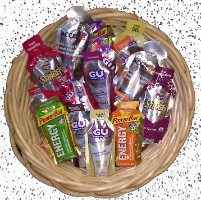 When we look at some of the biggest issues endurance athletes face, the balance between nutrition and fluid intake to successfully fuel his or her activity without suffering GI distress and delay fatigue rate right up there with proper training and staying injury-free. Different types of upper and lower GI symptoms occur in ~45-50% of endurance athletes. The symptoms may be related to more than one causal factor. The physiology is complex, so the fuel (carbohydrate choices primarily) and fluid you put into your system may compound the problem(s).
When we look at some of the biggest issues endurance athletes face, the balance between nutrition and fluid intake to successfully fuel his or her activity without suffering GI distress and delay fatigue rate right up there with proper training and staying injury-free. Different types of upper and lower GI symptoms occur in ~45-50% of endurance athletes. The symptoms may be related to more than one causal factor. The physiology is complex, so the fuel (carbohydrate choices primarily) and fluid you put into your system may compound the problem(s).
The Physiology: When exercise is intense or when dehydration causes hypovolemia (decreased blood volume), exercise induces changes in blood flow by the virtue of shunting blood from the gut to the working muscles. This blood shunt effectively causes a bit of hypoxia to the GI tract and increases neural activity of the submucosa of the gut (the connective tissue). This change to the GI tract increases the secretion of certain hormones and decreases absorption through the intestinal cells. This combination induces diarrhea, intestinal cramping, delayed gastric emptying (extra pressure in the stomach-“slosh” factor), and some bleeding of the stomach and colon may result (which is why some individuals experience blood in the urine and stool). The common use of anti-inflammatory drugs (NSAIDs, aspirin) aggravate the bleeding and interferes with fluid balance at the level of the kidneys (perpetuating the dehydration issue). Anxiety tends to induce lower GI symptoms and of additional interest, there tends to be a sex difference in symptoms as well. Women have a 5 time increased risk of diarrhea, intestinal cramping, and side aches as compared to men; men tend to have greater risks of vomiting and nausea. Most of this increased lower GI symptom risk is attributed to the fluctuation of estrogen and progesterone, with a greater incidence of lower GI issues during the 5-7 days preceding menstruation (aka the high hormone phase of the menstrual cycle). But the ingestion of fructose also contributes to women’s GI distress and dehydration.
With energy gels being one of the preferred sources of calorie-dense-easy-to-put-in-the-pocket- fuel-sources, I thought I’d spend some time explaining why these are one of the most detrimental fuel sources for performance…
First, let’s look at the overall nutritional scope. Of a standard gel, the calorie content ranges from 100-120 kcal per serving (typically 33-40g), comprised of maltodextrin and fructose, with a bit of sodium, potassium, flavorings and preservatives. Most usage directions state that a gel must be consumed with 2-4oz water. Here’s where it starts to get tricky.
In basic terms, a gel is a concentrated carbohydrate: minimum 73% solution (73g CHO per 100ml). By recommending water, the companies are trying to reduce the concentration of this solution. Why? Osmolality and carbohydrate concentration affect gastric emptying: the higher the osmolality, the slower the gastric emptying; the higher the carbohydrate concentration (even mixed sugars), the slower the gastric emptying1. By the nature of the concentration, a gel will sit in the stomach and increase the osmotic pressure, drawing water into the stomach to effectively dilute this pressure and allow the solution to exit into the small intestines. This is the first place of “effective dehydration”.
The second factor is the carbohydrate matrix of the gel. Research does show that the combination of two sugars is much faster than one for promoting carbohydrate absorption. When fructose and glucose are ingested in combination (either as fructose plus glucose, or as sucrose) the mean oxidized amount of the mixed sugars is ~66%, as opposed to fructose at 29% (women) to 45% (men) and glucose at 58%2. But the actual absorption rate of the sugars is the contention here: glucose is absorbed from the intestine into the plasma via more than one active glucose co-transporter protein; reducing the contact time with the gut lumen. Fructose, however, is less efficient and slower to be absorbed due to less active transport mechanisms; leading to increased contact time with the gut lumen. Why is contact time significant? With incomplete and slow absorption, fructose produces a hyperosmolar environment in the intestines. What this means is that there is more solute than water, causing an increased pressure, signaling fluid to be drawn into the intestines, producing the known feelings of bloating, gas, diarrhea, and general GI discomfort.
Maltodextrin, a polysaccharide with the building blocks of glucose, is used in gels instead of straight glucose for several reasons. The primary rationale that maltodextrin does not affect osmolality as significantly as glucose, fructose or dextrose. Because maltodextrin is a long chain of glucose molecules, it doesn’t add as much to the number of solutes in a solution, thus a solution (gel or sports drink) can contain quite a bit of maltodextrin and still have a faster gastric emptying rate. From a carbohydrate availability standpoint, this is appealing as resultant glucose molecules are absorbed through the several glucose co-transporter proteins. Here is the caveat: because maltodextrin is a long chain of several glucose molecules, it is not completely broken down in the stomach; but continues in the small intestines. In the small intestines3, these multi-chain glucose molecules create the same hyperosmolar environment in the intestines as fructose.
Final words. Why not gels? First, they are a concentrated carbohydrate ingested into a compromised gut (blood flow is diverted to the muscles and skin), increasing the osmotic pressure within the digestive system (read: slow gastric emptying, water drawn into the stomach to aid in the emptying). Second, they are usually comprised of maltodextrin and fructose; the two carbohydrates which create a significant hyperosmotic environment in the small intestines, causing additional water to be pulled into the GI tract to reduce the pressure exerted by the sugar molecules. Why is this significant in the world of training and performance? Fluid loss during exercise is difficult to mitigate and maintain blood volume. Blood volume is critical for sweating and muscle metabolism. Why would you ingest a product that accelerates dehydration and GI distress?
 Stacy Sims, MSc, PhD, served as an exercise physiologist and nutrition scientist at Stanford University specializing in recovery and nutritional adaptations for health, body composition, and maximizing performance. During the past decade she has worked as an environmental physiologist and nutrition specialist for top professional cyclists and triathletes, ultra-endurance athletes, the Garmin/Slipstream Pro Cycling Team, USA Cycling Olympic Team (BMX and women’s track cycling), Team Tibco, Flying Lizard Motorsports, and Team Leopard-Trek, among others. She competes as a Cat 1 road cyclist and elite XTerra triathlete and is co-founder of OSMO Nutrition.
Stacy Sims, MSc, PhD, served as an exercise physiologist and nutrition scientist at Stanford University specializing in recovery and nutritional adaptations for health, body composition, and maximizing performance. During the past decade she has worked as an environmental physiologist and nutrition specialist for top professional cyclists and triathletes, ultra-endurance athletes, the Garmin/Slipstream Pro Cycling Team, USA Cycling Olympic Team (BMX and women’s track cycling), Team Tibco, Flying Lizard Motorsports, and Team Leopard-Trek, among others. She competes as a Cat 1 road cyclist and elite XTerra triathlete and is co-founder of OSMO Nutrition.
Recommended reading
1. Murray R. The effects of consuming carbohydrate-electrolyte beverages on gastric emptying and fluid absorption during and following exercise. Sports Med, 4(5):322-51, 1987.
2. Sun SZ & Empie MW. Fructose metabolism in humans-what isotopic tracer studies tell us. Nutr&Metab, 9:89, 2012.
3.Lambert G.P., Change R.T., Xia T, Summers, RW, and Gisolfi CV. Absorption from different intestinal segments during exercise. JAP 83:204-212, 1997.